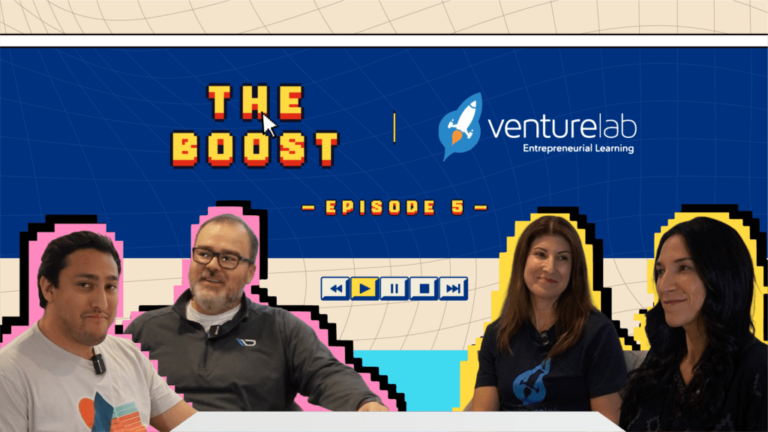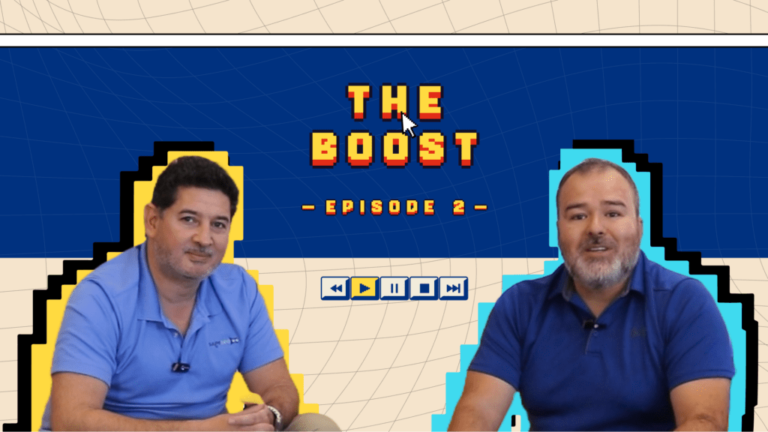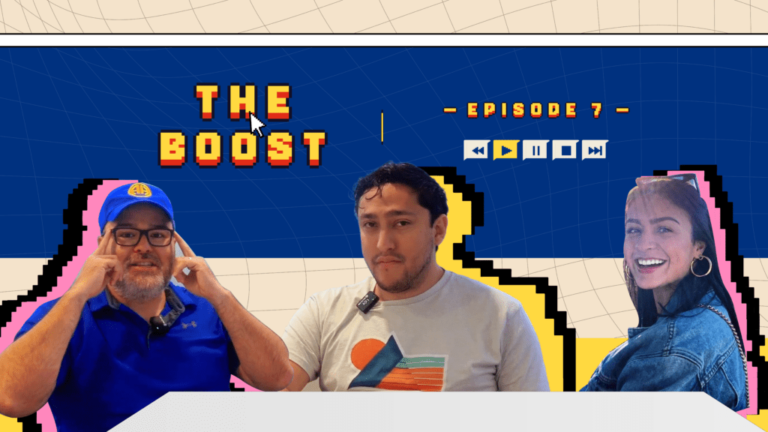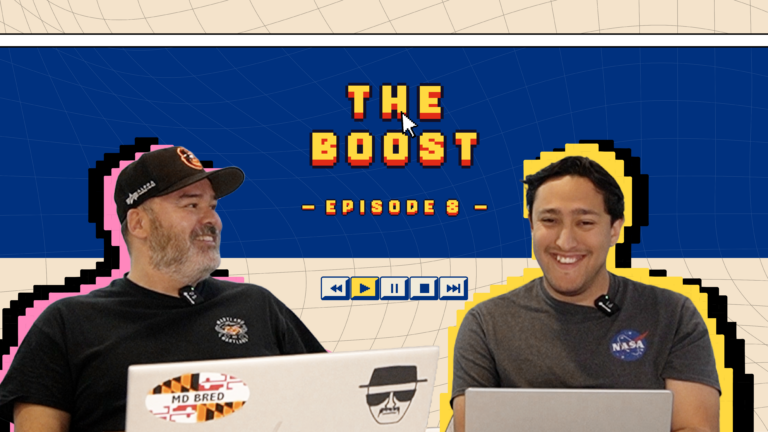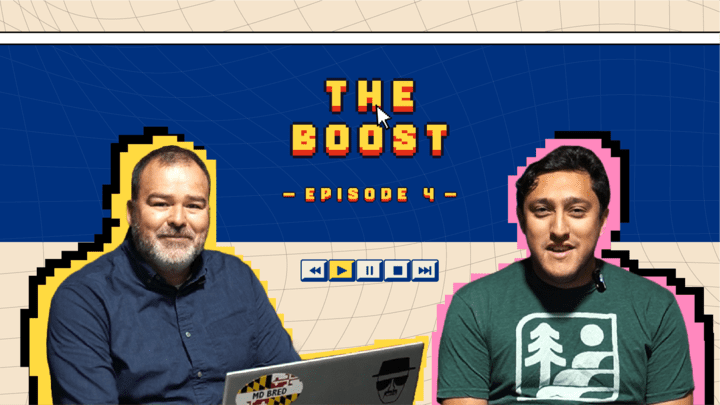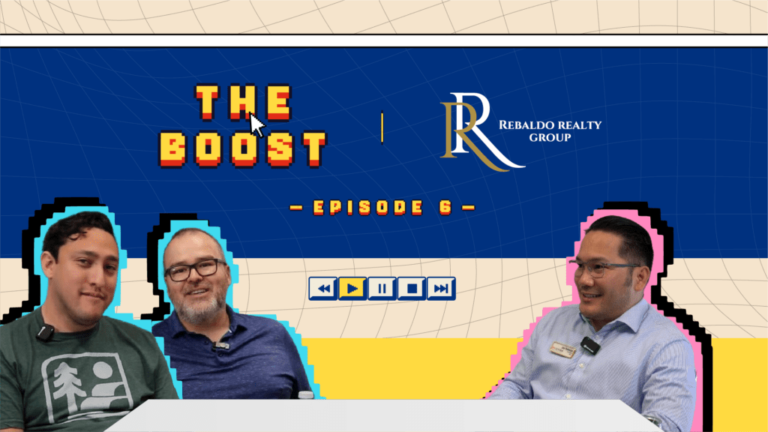Host Leon welcomes Zach and Alberto from Nonprofits HQ to discuss their journey in the nonprofit sector, the challenges they faced starting up, their move to San Antonio, and their mission to improve nonprofit operations through technology.
Nonprofits HQ: Website
YouTube:
Podcast:
Hosts:
Pablo Calvo: Linkedin
Find Us:
YouTube: https://www.youtube.com/@TheBoostChannel
Spotify: https://open.spotify.com/show/2AHGT1Aoq9oAHZEHeORBpa?si=1cea25e611bb4ec6
Apple Podcasts: https://podcasts.apple.com/us/podcast/the-boost/id1720047128
Facebook: https://www.facebook.com/TheBoostChannel
Website: https://theboost.fm
Key Points Discussed:
Nonprofits HQ Origins and Mission:
- Zach founded the Bites Foundation and faced challenges with nonprofit operations.
- Nonprofits HQ was born out of the need for a unified platform for nonprofits to manage operations efficiently.
- Mission to provide a comprehensive, easy-to-use platform for nonprofits to enhance their impact without being overwhelmed by technology or costs.
Moving to San Antonio:
- Zach and Alberto decided to move to San Antonio from Phasix due to lower costs and to extend their runway as a bootstrapped startup.
- They were attracted to San Antonio’s growing tech ecosystem, particularly Geekdom, a hub for resources and networking in the city.
Community and Resources:
- Nonprofits HQ is tapping into local resources for nonprofits, such as Bridging the Gap.
- San Antonio’s unique position as a cybersecurity hub also provides a vibrant community and support for nonprofits.
Dynamic Roles and Responsibilities:
- Both Zach and Alberto wear multiple hats in the business, handling all aspects of technology and operations due to their bootstrap nature.
Product-Driven Approach:
- Customer feedback drives the development of Nonprofits HQ’s platform.
- The goal is to create an “everything you need” platform for nonprofits, eliminating reliance on spreadsheets and disorganized data management.
Impact and Success Stories:
- Although still early stage, Nonprofits HQ is working towards making compliance and operational efficiency attainable for all nonprofits.
- They have developed tools to assist with governance, compliance, and operational efficiency to better demonstrate impact and secure funding.
Platform Features and Launch Plans:
- Nonprofits HQ’s platform is built with artificial intelligence to make setup and operations intuitive and affordable.
- The platform is designed to be interconnected, ensuring that all aspects of a nonprofit’s operations are streamlined and efficient.
Vision and Goals:
- Nonprofits HQ aims to be a leading platform that meets the diverse needs of nonprofit organizations.
- The company is exploring new features, such as grant management and possibly payroll services, based on partner feedback.
Advice for Aspiring Social Entrepreneurs:
- Nonprofits HQ provides a free formation portal for those looking to start a nonprofit, guiding them through the legal and regulatory steps.
- Zach and Alberto emphasize the importance of compliance and sound operations from the outset to avoid future hurdles in growth and funding.
Closing Remarks:
- Nonprofits HQ is set to officially launch on May 1st.
- The platform aims to be a go-to resource for existing nonprofits and individuals seeking to start their own nonprofit organizations.
Leon (00:00):
Hello, welcome to The Boost. This is the next episode. Today I have Zach and I have Alberto with Nonprofits HQ. All right, welcome to the podcast and The Boost. I know you guys have been around, geeked them for a little bit. You’ve been talking and I’ve talked to you, Zach, I talked to you a little bit, Alberto around here, but I want to learn a little bit more about Nonprofits HQ, how did it get started and what are your guys’ background?
Zach (00:31):
Yeah, definitely. First, thanks so much for having us. We love opportunities like this to talk about what we’re doing and the types of stuff that we’re working on. So yeah, nonprofits HQ actually started back when I started the Bites Foundation, which is a nonprofit organization that provides technical services to other nonprofits across the United States. And when we started this one, we didn’t really know what we were doing. We knew we wanted to do good and we knew we wanted to help other organizations, but we didn’t really fully understand what the structure of a nonprofit should look like, what governance, what operations, what compliance, what all these pieces should look like, and looking at different tools to help us figure this out. It was crazy. There’s a bunch of different tools that don’t work together that are super disconnected and crazy expensive. We’re a brand new nonprofit, we don’t have dollars yet. And so I started writing some software. At first it was very tailored to what we needed. Very ugly, very hard to use, very,
Leon (01:30):
It was an MVP, it
Zach (01:32):
Was probably junior MVP. Anyway, so I was at lunch with some other executive directors one day and I was talking about it and was showing them, and they also agreed, yeah, it’s ugly, it’s hard to use, but this could be something that would be super beneficial to us. And that’s when I was like, okay, actually, if we kind of clean this up and we turn it into a useful platform, this technology, this tool could be used to empower people to do good all over the country. So we can really amplify that impact and help organizations amplify their impact in ways that makes sense to them.
Leon (02:08):
That’s really cool. So my understanding of your background too is you started in Phasix, you moved to San Antonio, recently added Alberto as a co-founder. You want to share a little bit of moving from one city to another. That’s a big jump.
Zach (02:25):
Definitely. Yeah. So we are hyper-focused on the company. That’s what I wanted to do. And what that means when you’re bootstrapped, you haven’t taken in any VC funding or anything like that. That means you need runway. That’s what you care about is runway cost of living in Texas is way lower than cost of living in Arizona. But it’s interesting that we ended up here in San Antonio too though, because when I’m thinking about different places to build a tech company, San Antonio is not on that list. You think like the Bay Area, San Francisco, you think la, Miami, maybe New York, maybe
Leon (03:04):
A little bit of Austin,
Zach (03:06):
Maybe a little bit of Austin. And I knew that it made sense. Texas and Florida typically makes sense for tax structures for companies. But when you Google startups and resources for startups in San Antonio or in Texas, geekdom is in a lot of that. There’s a lot of mentions, a lot of resources that Geekdom provides, and that’s kind of what made us think like, oh, maybe San Antonio is what makes sense to us.
Leon (03:32):
Okay, that’s really interesting. So you’ve got the community around here, geekdom still, technology quite isn’t the fit of what nonprofits is doing. As you’re going through that, have you run into more nonprofits? Is there some sort of resource pool for nonprofits in the city that you guys have tapped into outside of the tech building?
Zach (03:55):
Yeah, definitely. So there’s organizations like Bridging the Gap, and it was really sad to hear about Sal, but they connect organizations, nonprofit organizations for networking and to connect with resources. We’ve kind of tapped into that. We’re looking at various different resources in San Antonio. San Antonio is known as the cybersecurity capital of the world, I think, or at least the country as the mayor put it.
Leon (04:21):
It’s all the military and military bases that surround it. So it makes some degree of sense,
Zach (04:26):
Absolutely. But there’s also a lot of just nonprofit organizations and philanthropic, that’s not a real word, but triple E minded people here. And one of the cool things that we’ve kind of discovered is as we’re talking to people, as we’re meeting new people, they either are on a nonprofit board or a high level volunteer or some sort of executive in a nonprofit or their spouses or their friend is or something like that. And a lot of the connections that we made through these interactions have led to us being able to work with these nonprofits and really learn about them and understand how they’re working. I dunno if I’m rambling or if I answered your question.
Leon (05:08):
No, you did. Backing up a little bit, how do you guys, you have a dynamic here. What are the kind of roles that you guys divide up? Are you doing the tech? Are you doing the tech? Or is it kind of a meld because you guys are bootstrapped, you guys aren’t building something and it’s just two of y’all? How’s that dynamic going?
Zach (05:30):
Yeah, definitely. So in terms of the company structure and division of responsibilities, I handle all the tech and Alberto handles all the tech. I handle all the business, and Alberto handles all business.
Leon (05:43):
It’s all the hat.
Zach (05:44):
Absolutely. Absolutely. And that’s really how we’ve learned. We work really well together. We’ve known each other for 10 years,
Leon (05:53):
Both moved from Phasix
Zach (05:54):
To Phasix. Yep.
Leon (05:56):
Two really big moves.
Zach (06:00):
One of the things that we kind of recognize is we have these skill sets. We have these areas where we need to grow as business owners, as obturator internus, but we can kind of combine the skills and experience and knowledge that we have and do everything, which is kind of required at this stage anyway. Right? Yeah.
Leon (06:18):
I find it really fascinating to have somebody move from a Phasix to San Antonio and build a startup here. You don’t see too many of that in San Antonio. They kind of go the other way to the West coast to go to Y Combinator and that stuff. But you’ve got a big resource pull. You’ve got mentors, you’ve got a lot of people here, and there is a ton of nonprofits popping up and geek them. So I think you guys are posed to do that. And I know Pablo couldn’t be here today, but he’s talked about having a cohort of nonprofit companies. I think you guys can really collaborate on that stuff.
Zach (06:54):
I think that would be amazing because nonprofits, while they’re more impact focused, it still numbers in and numbers out. It’s still got to be operated as if it were a business because the operations are like that. You have regulations, you have compliance, you have things you have to do. You have to balance budgets and keep programs funded. You have to do everything. You just don’t get to take home a bunch of profit. You get to take home a really good feeling for doing good and impacting your community. So I think the lessons and the programs that Geekdom provides absolutely are applicable to nonprofit organizations as well.
Leon (07:28):
Good way of thinking of it, because I think nonprofit and I think it breaks the capitalist system a little bit, but it is very true. There’s still money in, there’s still financial responsibilities to the people who are there serving and the people that are donating. So I understand that. Now I have a question on vision and the mission. Do you guys have some broad set of mission goals or some broad visions that you guys hope to do with nonprofits hq?
Zach (07:57):
Yeah, definitely. So when we first started this thing, we were like, okay, we’ve got this really cool software. We’ve got this really cool platform. It’s going to be amazing. All the nonprofits are going to need it. They’re going to use it. They’re all going to come and it’s going to be amazing. But what we’ve learned is we’ve grown and matured in that idea, is that we really need to understand the different subsets of organizations. Because in a nonprofit, for example, that is a pet rescue for example, and we work with a couple of those, it’s going to have different needs and slightly different requirements than say an organization that provides services to the homeless population in their community. There’ll be different regulations, different funding sources, different compliance requirements. And so as we’re learning about these different segments and working with new organizations, what we want to build is a truly everything you need platform to run your organization.
(08:53):
Whether you’re a new organization or an established one that’s been running for a while, we want one place that has everything you need, useful, impactful tools that you need to run a smooth, compliant, efficient organization. a lot of organizations that we talk to, even mid-size organizations, are still using spreadsheets to measure impact and track data. And we are working with an organization recently, all of the records for volunteers and board notes and things are on the notes app on the phone of the executive director. It’s like these people dedicate their lives to doing good. They’re focused on empowering people in their community, completing their missions, achieving their organization’s goals. They already have a million things to worry about. Tech should absolutely not be one of those. And so our whole belief is that our TE needs to meet our users on their terms, right? An organization shouldn’t have to one empty their checking accounts or two completely change everything they’re doing about how their mission works in order to have access to a tool to make them more efficient, to empower them, to empower others. And so our belief is that tech, our tech should absolutely meet users on their terms. And that’s why we don’t build anything unless we are talking with an organization and understand that need completely.
Leon (10:16):
So product led to some extent, customer led more. So I like what you said though, that tech kind of blends into it, that you’re a platform that’s helping the nonprofit, the technology is a core part of it, but in the end, it’s just something that’s a little bit nascent to them. They’re using it, they’re helping being more compliant, and the mission there is just to make better run nonprofits.
Zach (10:40):
Absolutely. Right. Absolutely.
Leon (10:43):
I know you touched on it a little bit. Any other success stories? Have any nonprofits had compliance issues and then went to being compliant with y’all?
Zach (10:53):
So we’re still pretty early stage. So in terms of our official launch date is May 1st, right? So we could completed a program
Leon (11:01):
Beta.
Zach (11:02):
So we’d successfully completed a beta program and have solidified the platform based on that feedback with a handful of organizations and have begun making sales and onboarding new customers. So it’s a little early to say complete turnaround, no compliance works that fast. But I will say a lot of the organizations we talk to, a good example of one of our partners is, and I want to highlight that they’re partners, they’re not customers. And this kind of goes back to that customer driven product roadmap. We want to work with them to create an environment that works for them that helps them accomplish their goals. We’re not just selling them a piece of software and saying, good luck, have fun with it. Moving on to the next sale. But yeah, so this organization, amazing organization, they provide services to the homeless population, showers, meals, a place to lockers to leave your stuff.
(11:59):
So you have a job interview, haircuts and preparation for the job interview, things like that. And they’re all grant funded. They’re completely grant funded, which means there’s a lot of regulatory requirements and compliance requirements that come along with those grants. One of those is that they have to collect government issued IDs from all of the people that they serve now, requiring government issued IDs for a homeless population to provide services is problematic for sure. Not the problem we’re solving unfortunately, but it is problematic. But the way they were doing this was with spreadsheets. So they had all these different programs. Each program had a spreadsheet and each spreadsheet had tabs or pages in that sheet that had the date of the last service or program for that. And so the way they were doing this is they would take the ID and they would search command F and search in the spreadsheet for the ID number or the name or some piece of information on that.
(12:52):
If they couldn’t find it, they’d add a new row and fill it in. If they could find it, they would mark that check the little box that they were good. And there’s several problems with that because one, you can’t really draw easily insights on that data. You can’t reliably track what your actual impact is. How many people did you actually serve? What services did you actually provide? This grant, the main funding source had requirements that a specific person could only receive that service within so many times within a period, things like that. So there’s no way that they’re able to really reliably understand and demonstrate what it is that their organization is doing. And they’re actually the organization we worked with to build what is the impact product on our platform. The benefit of a unified platform is all of the data is there, all of the data happens.
(13:43):
So insights and impact and reporting, all of that just happens for these organizations. So they went from having all this data, which is also personal, kind of protected data, sitting on someone’s laptop, showing a complete stranger as we’re understanding their problem. And to industry standard encryption, data protection practices and protocols that our platform has security, compliance and certifications, but also the ability to actually clearly demonstrate what it is they’re doing, how many people they’re serving, how many things they’re doing, what it costs them to do that, so then they can now project what they need to raise, what grant sources they need, things like that.
Leon (14:23):
That’s amazing to think about it. I do see these impact reports work with a lot of nonprofits and they put out an impact report, but it is very manual. They go and track back how many people have they touched? The money is the money. It’s easy to track that through bank accounts, but every other part is a hurdle. There is not that one central platform. But I am really interested in the fact that not only is it an impact report, but you’ve got this PI that’s being protected. And then you’ve also got the ability to pull some information to say, what is our financial health? How do we go raise for that? And I think that as a core feature is impact report goes and helps raise money, how much money do you need? And then servicing them, because I know every nonprofit needs to make money in a manner that’s being made, but they also have to watch their books. They can’t spend too much on administrative, they can’t spend too much on software. They have to be cognizant of those items. So it’s kind of cool to hear that that’s a platform, and I’m honestly kind of surprised that nobody else or no other tool out there has ever tried to do it. Is there some competition that’s on a top level that’s out there, or is this kind of a space that hasn’t been addressed ever? Neon one? Yeah,
Zach (15:48):
So I would love to say that nobody has ever thought of this, and we’re innovating innovative trailblazers.
Leon (15:56):
It’s not always the first to market. It’s sometimes the most well executed.
Zach (15:59):
Absolutely. And so there are competitors. So for example, one of the problems that we’re solving is the disconnection between these tools. You can go buy a fundraising platform, you can go buy a volunteer staff management platform. You can go buy a CRM from manager contacts. There are a couple products that help you track impact. They’re very manual though, and it’s still exporting these datas. And then you still, it’s a very manual process to generate these impacts. So the value that we provide is kind of pulling all that together, but not just taking a tool and putting it on the same ui, really making ’em work together to help the organization achieve their goals. Now, there are some competitors that are very similar to what we’re doing in this space. And part of the reason that I think we’re seeing the success and the traction that we’re already seeing is because our competitor software is hard.
(16:55):
You buy this software, one, you got to pay this crazy setup fee, and then you’ve got to pay. So the way they structure it is they have the CRM product then. So you buy that, you pay your setup fee, you buy that, you pay your monthly fees, typically billed annually, and you have a CRM. Now if you want to add fundraising to that, well, you can buy an add-on and you can pay setup fee for that. And then you can pay your monthly fees build annually, and you have fundraising. Now if you want to do something else like ticketing or eventing,
Leon (17:25):
It’s an add-on every part of the way.
Zach (17:28):
And it always increased costs. So we built our platform in such a way that, and our background is technical. And so we had the ability to architect this thing and we knew what our vision was. We wanted it to be easy, like crazy easy. Nonprofit, obturator, internus or leaders are typically not technical people. They don’t need to be. And we needed this to be easy and we needed it to be a way that’s not just that doesn’t cost a lot to set up and to operate. And the way we did that was build technology to help with these things. Like setups, competitors might charge a setup fee because there’s a implementation specialist or somebody that has to do stuff in order to set it up, whether it’s provisioning a new tenant or creating your domains or whatever it is. And so we’ve built our platform in such a way that it is powered by artificial intelligence and it really understands granularly what the organization is and how the platform should be set up for them.
(18:27):
And so it makes that recommendation during setup. They can accept those settings or modify ’em if they want and then move forward. So we really had to focus on the technology. While technology is just a tool to help them amplify their impact, we really focused and took a lot of care to ensure that it was a tool that didn’t also take up all their time, also take up all their money. So we bring everything in a unified platform. And unification is important. Like I said, it’s not just bringing all the different tools in one ui. They work together truly with all of the data in your organization to help you understand what it is your organization needs and what your next steps are at a price that doesn’t break your bank. And so an example of this, one of the platform apps is eventing, right? Organizations. They do a lot of events, sell tickets, things like that to raise money. And so with all of your stuff being in our platform, your event isn’t just selling tickets, it’s helping you set goals. It’s helping you understand based on the number of attendees or the number of tickets you have available, how many volunteers and how many staff do you need for that particular event? All manageable right there in the event interface. It’s all very cross connected to help you ensure that everything you’re doing is impactful and you’re maximizing your resources and time.
Leon (19:49):
I love that there’s a connection. Always. You’re running an event. How many volunteers do you need? You making an impact report? How do you run the nonprofit, the business? It is a business in the end. It’s just a business that’s giving a lot of cash out or impact in some capacity may launch, right? That’s the official big one. Anything planned for that outside of just a launch? Is there any new sets of features or anything you can share?
Zach (20:18):
Yeah, so one of the cool things about being super customer oriented is our customers help us kind of figure out what we should build next. And so one of the things that we established was a product advisory committee and different leaders from our customers organizations, our partner organizations, sit on that and help us figure out what makes sense on the software, what doesn’t make sense, what should be there and what shouldn’t. So we’ve got a lot of really cool things coming that they’re asking for grant management in writing, for example, tracking that, bringing that into the platform and other operations. I know payroll has been asked for a few times, and so there are some exploration happening there. But in terms of launch specifically, we are not planning on launching any additional features on mayday, but we are always working towards that roadmap and figuring out what makes sense. Okay,
Leon (21:12):
Really good. I’ll make sure to link everything so people can go check it out. And I think this episode will come out probably mid April, so it’ll be good timing wise. The other question that I’ve got is advice for aspiring social entrepreneurs. There’s so many people that want to do a nonprofit, they want to have some impact. They’ve had something happen in their life or had a family friend. And that’s generally where I see a lot of nonprofits form from some sort of impact on somebody’s life. And then they go, man, I want to solve for this. I want to create problems or not create problems, but solve
Zach (21:50):
Problems, create solutions, solutions
Leon (21:52):
To those problems. Any sort of advice. Does the platform help with any of that or is there just general advice on starting it? Because a 5 0 1 C3 is a hard hurdle to get through for any business. It’s not just an LLC.
Zach (22:06):
Definitely. Yeah, absolutely. And so I’ll give my answer to this and I’ve kind of monopolized the conversation, so then I’ll turn it over to Alberto for That’s alright answer as well. So there’s a couple aspects to that, whether you want to start a company or I’ll talk specifically around nonprofits. Our space, there are a lot of things you have to do. You have to understand what is required to start that. You have to figure out what problem you’re going to solve. And like you said, usually that comes from something that happened in your life or something close to you. But knowing that you want to solve a problem doesn’t get you past all the regulatory filings and everything that you have to. So one of the cool things that actually started as kind of a marketing experiment on our platform is what we’re calling the formation portal.
(22:49):
So it’s organizations and we don’t charge anything at all for this part of the platform. It’s people that want to start a nonprofit but don’t quite know where to begin. What do I need to do? So I need an IRS thing that says I don’t have to pay taxes, but what does that actually mean? And so the platform breaks down because the platform nonprofits HQ understands at a very granular level all of the regulations and requirements for nonprofit organizations across the United States, whether that be local, state or federal level. And so we’re able to take that information, that data that the platform already knows and make it available to them. I want to start this nonprofit here in San Antonio to do, I dunno, to rescue pets. I love doges, right? And so how do I do that, right? Well, I need to file some certificates of formation.
(23:34):
I need to have a legal entity. I need an EIN, I need tax exempt status. But before I can do that, I need to form a board. That board can’t be related to each other. There has to be an unbiased quorum. All of these different. And so our platform lays out all the steps that you need to form that organization where you currently are, how much that’s going to cost, where you actually do that filing. So one of the large points of confusion and frustration for starting a nonprofit is often the IRS exemption process for that 5 0 1 C3 designation. They have a few different options. You can use the easy form where it’s a much faster process. You don’t have to supply nearly as much information, but then you’re restricted to raising not more than $50,000 in your first three years or you can, but that costs is like $250 I think.
(24:23):
And you usually get that designation in a few months. Or you can do the long form, the 10 23 long form, which is like $600 and you have to submit operating budgets. And it’s a very long process because they’re not spot checked. They’re fully vetted on each of those applications because the IRS is very concerned with financial misconduct, which can happen in nonprofit situations. And so there’s all these different options. Most people when they want to start an organization, they don’t know one that they should think about those things. They don’t know how they should approach those things. And so our platform, we have all that anyway, so we just made it available to these organizations or these people that want to start organizations. And even if you know, okay, I want to do this and I know I need to file a 10 23 form, where do I do that? What is it going to cost me? So our platform has videos kind of explaining each of those steps in simple terms, easy to follow terms, quick bite-size videos, and it links you directly to the portals you need to pay the IRS to file the forms to file with your secretary of state in whatever state you’re in. Those types of things.
Leon (25:27):
That’s amazing. I knew the process was hard, but I didn’t realize there’s so many steps that there’s different types of 5 0 1 c threes, even a restriction on that, that is kind of mind blowing. And I understand that there’s financial fraud and nonprofits can sometimes be the targets of that, but just the setup can be daunting for a lot of folks. But I have run into a number of people that have said, I want to do a nonprofit. I want to help out in this way. And then that’s as far as they can get. So having a place to go and saying, okay, this is the forum that is really, really impactful to getting more people out there.
Zach (26:14):
Absolutely. And we offer that free of charge. There are no fees, nothing collector credit card to create that portion. And the reason we do that is because, one, our goal is to empower people to do good. We have that information and that functionality sitting around on the platform anyway, so we can take a limited function or a slice of the platform and make it available to those partners who then we already know and they’re already familiar with our platform. And then we can kind of grow together from there once they’re established and going. And so yeah, it’s a lot of steps. It’s a lot of information and we’re not by any means providing tax advice or legal advice. It’s more of a guide of what typically should happen given your situation in the particular organization you want to start. But yeah.
Leon (27:01):
Very cool. Anything else you guys want to share?
Alberto (27:07):
I mean, you said it all.
Zach (27:10):
Yeah, so I think there’s a lot of opportunity to bring tech and social good together. And that intersection is really what we’re hyper-focused on. And I think there are a lot of focus on these high markets with multi-trillion dollar tams, for example, high market sizes because of the returns on those are going to be much higher. But I think if we can focus on bringing useful technology and creating equitable access to tech for the folks that dedicate their lives to doing good, we can not only build a platform that is easy and nice to use and helps them be more efficient and compliant, but we can actually directly impact the goodness in the world. And so we’re on that. And I think more people need to think about their nonprofit organizations, how they’re running it, ensure that they’re compliant. Because it doesn’t matter now when you are raising a few thousand dollars maybe a month, but when you start going after these grants and when you start really needing to bring in those dollars to further your mission, you’re going to look back and you’re going to wish you had something in place because every bit of your financial data is now into consideration.
(28:30):
Taking into consideration. It’s for what you want to do. And it’s all very public. So I’m rambling. I had a point and then I lost it.
Leon (28:39):
All good. All good. Well, I really appreciate you guys coming on and sharing what you’re doing. I’ll put in the show notes for everybody. The nonprofits hq, it’s launching May. Is there a date in May?
Zach (28:53):
First? May day.
Leon (28:54):
Okay. May day May 1st. And anybody that wants to start a nonprofit could go check you guys out. I think that’s a super powerful tool. And then anybody that’s running a nonprofit or operating in a nonprofit can look May 1st and start the signup process. Thank you so much, Zach. Thank you so much, Alberto. I’ll put in the show notes nonprofits hq.com, and then I’ll put in information on the launch date and all of that. It’s May 1st. Thank you guys for listening. Please subscribe to the podcast on Apple Podcast on Spotify, YouTube, and you can check us out at the Boost fm.
Zach (29:30):
Thank you so much, man. It was great to be here.

